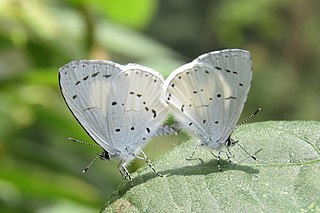
Leptotes plinius, the zebra blue or plumbago blue, is a species of blue butterfly (Lycaenidae) found in Sri Lanka, India to Australia. The species was first described by Johan Christian Fabricius in 1793.

Logania watsoniana, or Watson's mottle, is a small but striking butterfly found in India that belongs to the lycaenids or blues. The species was first described by Lionel de Nicéville in 1898.

Callenya melaena, the metallic hedge blue, is a small butterfly found in India that belongs to the lycaenids or blues family.

Udara akasa, the white hedge blue, is a small butterfly found in India that belongs to the lycaenids or blues family.
Celastrina albocoeruleus, the albocerulean, is a small butterfly found in India that belongs to the lycaenids or blues family.

Nacaduba berenice, the rounded six-line blue, is a lycaenid butterfly found in Indomalayan realm. The species was first described by Gottlieb August Wilhelm Herrich-Schäffer in 1869.
Episcepsis is a genus of tiger moths in the family Erebidae. The genus was erected by Arthur Gardiner Butler in 1877.

Spilosoma batesi is a moth of the family Erebidae. It was described by Walter Rothschild in 1910. It is found in Nigeria, Cameroon, Congo and Zaire.

Amerila astreus is a moth of subfamily Arctiinae described by Dru Drury in 1773. It is found from the Oriental region to New Guinea. The species is found in primary and secondary habitats ranging from lowlands to montane regions.

Episcepsis demonis is a moth of the family Erebidae. It was described by Herbert Druce in 1896. It is found in Panama and Peru.
Episcepsis frances is a moth of the family Erebidae. It was described by Harrison Gray Dyar Jr. in 1910. It is found in Mexico, Costa Rica, Venezuela, French Guiana, British Guiana, and Peru.
Episcepsis gnomoides is a moth of the family Erebidae. It was described by William Schaus in 1910. It is found in Costa Rica.
Episcepsis lenaeus is a moth of the family Erebidae. It was described by Pieter Cramer in 1780. It is found from Mexico to the Guianas.
Episcepsis capysca is a moth of the family Erebidae. It was described by William Schaus in 1910. It is found in Costa Rica.

Episcepsis thetis is a moth of the family Erebidae. It was described by Carl Linnaeus in 1771. It is found in Panama and Venezuela.

Episcepsis venata is a moth of the family Erebidae. It was described by Arthur Gardiner Butler in 1877. It is found in Mexico and the Amazon region.

Episcepsis sixola is a moth of the family Erebidae. It was described by William Schaus in 1910. It is found in Costa Rica.
Miacora leucocraspedontis is a moth in the family Cossidae. It was described by Zukowsky in 1954. It is found in Peru. The wingspan is about 25 mm. The forewings are bronzy-steel blue with a weak cream-coloured streak from the base of the costa to beyond the middle, broadening posteriorly, both before and beyond the fold. There is a creamy-white to fuscous postmedian streak, prolonged above the dorsum towards the tornus. The strongly dentate transverse line is edged with blue and there is a creamy-white spot in the middle of the discocellular, as well as a small one basal, reaching two-thirds across the wing. The hindwings are light tan, with a brown-grey submedian band reaching the termen, and415 with a bluey-white apical point.
Dichomeris excavata is a moth in the family Gelechiidae. It was described by August Busck in 1914. It is found in Panama.

Lobesia fuligana is a moth belonging to the family Tortricidae. The species was first described by Adrian Hardy Haworth in 1811. It is found in Europe.










